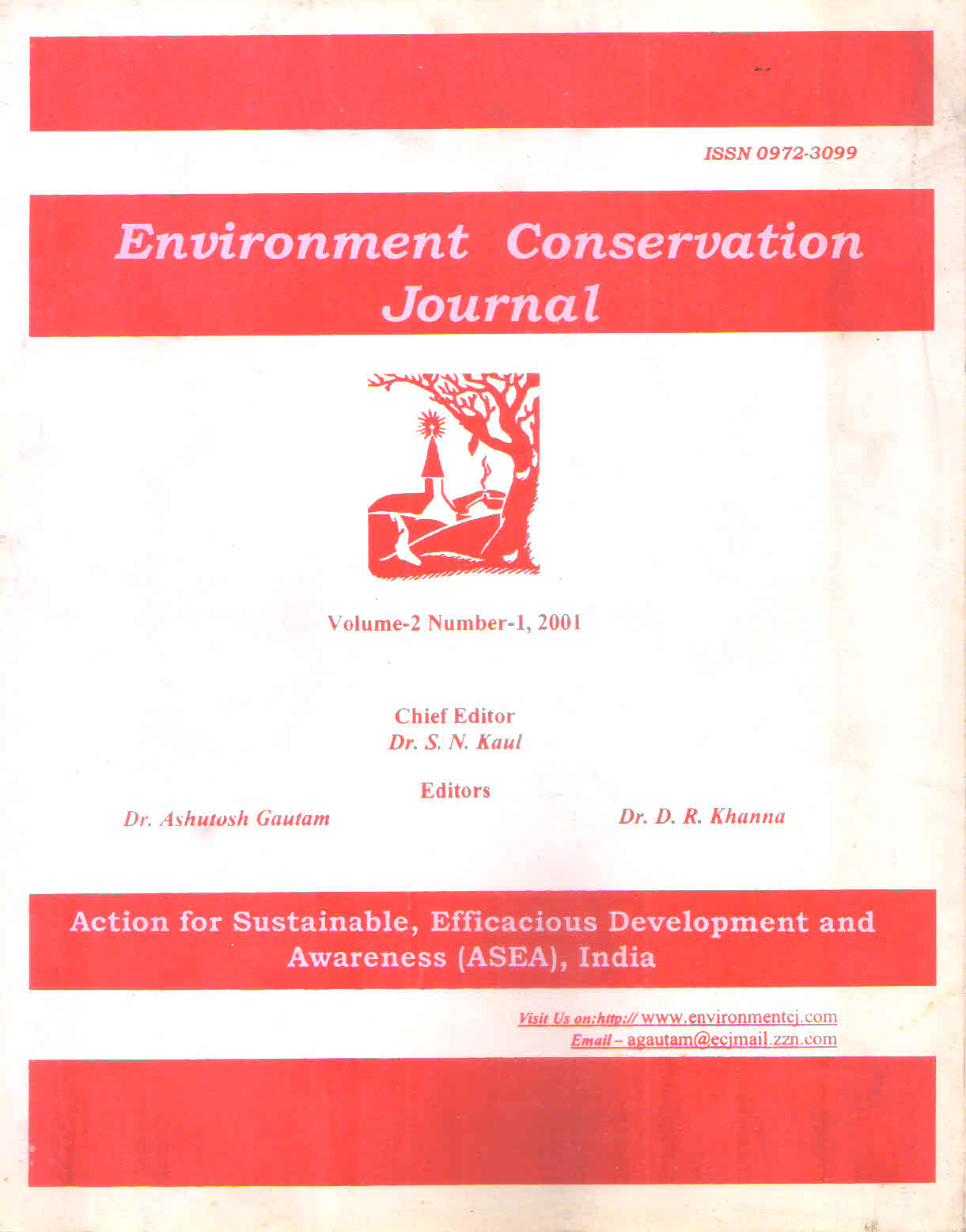Main Article Content
Abstract
The present paper describes fluctuation in the population density of Macro-Invertebrates of river Ganga at Pashulok Barrage, Rishikesh. This investigation was carried out between September 1998 and Feb 1999. Total Eight groups of Macro invertebrates were observed. Out of which, Diptera (33.52%). Ephimeroptera (30.62%), Gastropoda (13.65%) and Trichoptera (10.59%) dominated over the other groups. The population of Macro-Invertebrates found maximum in the month of February, whereas the minimum values were recorded in September.
Keywords
Article Details
Copyright (c) 2001 Environment Conservation Journal

This work is licensed under a Creative Commons Attribution-NonCommercial 4.0 International License.
References
- APHA 1976. Standard Method ofExamination of Water and Wastewater, APHA, New York.
- Joshi, B. D., Bisht, R. C. S., Joshi, Namita and Singh, Rajendra 1996. A study of planktonic and benthic components of three selected tributaries of river Ganga between Devprayaag and Rishikesh. Him. J. Env. Zool.10, 23-26.
- Khanna, D. R. l 993. Ecology and Pollution of Ganga River. Ashish Publishing House, Delhi. pp 1-241.
- Needham, J.E. and Needham, P. R. 1972 4 Guide to the Study of Fresh water Biology. Holden Day Inc. San Fransisco, California.
- Pratt. M . J., Coler, A.Rand Godfrey, J.P. 1981. Ecological effects of urban storm water runoff on benthic macro-invertebrates inhabiting the Green river, Massachusetts Hydrobiologia. 83, 29-42. DOI: https://doi.org/10.1007/BF02187149
- Richardson. R. F. 1921. Changes in bottom and share fauna of the middlellliinois River and its connecting lakes since 1913-1915, as a result of the increased southward of sewage pollution.l//inois Nat. Hist. Sur. Bull.14, 33-75. DOI: https://doi.org/10.21900/j.inhs.v14.312
- Singh, Arun K.1997. Abundance of Macro-zoobenthic organisms in relation to physico-chemical characteristics of river Ganga at Patna ( Bihar). India J. Environ. Biol. 18(2), 103-110.
- Vig. Monika 1998. Limonology of "Hindon" with Reference tolimpact of Sewage and Industrial Effluents of Benthic Organisms. Thesis for Ph.D. in Zology, Chaudhari Charan Singh University, Meerut. PP 1-167.
References
APHA 1976. Standard Method ofExamination of Water and Wastewater, APHA, New York.
Joshi, B. D., Bisht, R. C. S., Joshi, Namita and Singh, Rajendra 1996. A study of planktonic and benthic components of three selected tributaries of river Ganga between Devprayaag and Rishikesh. Him. J. Env. Zool.10, 23-26.
Khanna, D. R. l 993. Ecology and Pollution of Ganga River. Ashish Publishing House, Delhi. pp 1-241.
Needham, J.E. and Needham, P. R. 1972 4 Guide to the Study of Fresh water Biology. Holden Day Inc. San Fransisco, California.
Pratt. M . J., Coler, A.Rand Godfrey, J.P. 1981. Ecological effects of urban storm water runoff on benthic macro-invertebrates inhabiting the Green river, Massachusetts Hydrobiologia. 83, 29-42. DOI: https://doi.org/10.1007/BF02187149
Richardson. R. F. 1921. Changes in bottom and share fauna of the middlellliinois River and its connecting lakes since 1913-1915, as a result of the increased southward of sewage pollution.l//inois Nat. Hist. Sur. Bull.14, 33-75. DOI: https://doi.org/10.21900/j.inhs.v14.312
Singh, Arun K.1997. Abundance of Macro-zoobenthic organisms in relation to physico-chemical characteristics of river Ganga at Patna ( Bihar). India J. Environ. Biol. 18(2), 103-110.
Vig. Monika 1998. Limonology of "Hindon" with Reference tolimpact of Sewage and Industrial Effluents of Benthic Organisms. Thesis for Ph.D. in Zology, Chaudhari Charan Singh University, Meerut. PP 1-167.





